Video: Picasso
The Mystery of Picasso
A small blog about my favourite works of art, and a little bit about the artists that created them.
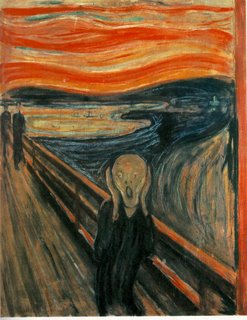
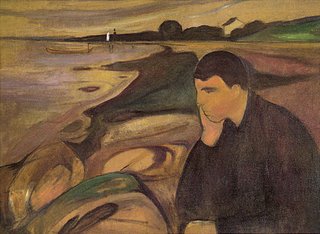

There are three figures here. An old man, and old woman, and a young woman. The old man is moving forward but he is trying to reach backwards towards the young woman, who is reaching out to him. The old woman has her arm draped around the old man offering a comforting strength and guiding him forward. His expression is one of agony. He wants to stay, he wants what is behind him. The old woman's expreassion is one of understanding, even pity, but also strength and resignation. The young woman reaches out to the old man with a true longing. Her expreassion is one of begging, pleading, and need.
Life goes in only one direction...towards the future. There comes a time when we have to let go of our past. Put away the desperate desires of youth. Maturity is about facing that time with dignity. Letting go of youth and accepting mortality. Coming to terms with ageing and dying.
Does the young woman represent all that was wonderfull and desireable in the old man's past. Is this why he is reluctant to leave her behind? Is this sculpture a symbol of every mid-life crisis?
Claudel was Rodin's lover and student. But he refused to leave his long term love, Rose, in favour of her. She realised that she would never be Rodin's wife. Is this sculpture just Camille on her knees begging Rodin to stay with her and leave Rose? Perhaps. Perhaps it is that...and more. But I know what it meant to me.
I had just turned 50 when I first saw this piece. I had also been recently diagnosed with leukaemia. Maturity touched me very deeply. It is now, and will remain, one of my favourite works of art.
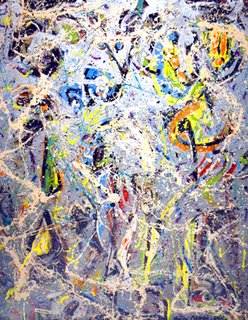

The painting above is called "Blue Poles", painted in 1952. At first glance there is little to be understood in Pollock's works. But the more of his works you see, the more you appreciate the talent of the artist. Trying to make sense of Pollock's canvasses is hopeless. Even Pollock eventually stopped naming his works. Why project a name onto something that is pure expression?
Pollock had a short and troubled life. Alcoholism and depression accompanied his success. He died in a car crash at the age of 44.
If anyone is interested in trying their hand at Pollock's style, here is a website that might interest you: http://jacksonpollock.org/
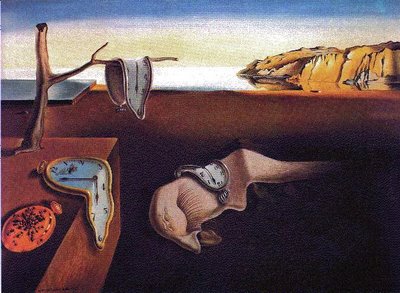 The painting above is called The Persistence of Memory. Dali painted this in 1931 when he was 27 years old. He was, by this time, one of the most famous of the Surrealist artists. Surrealism attempts to portray, through contrasting and illogical imagry, the landscapes of the subconcious mind. Dali was greatly influenced by the new ideas put forward by Sigmund Freud, the father of psycho-analysis. I am fascinated by the ability of Dali to provoke the subconcious mind, to entice it into the conciousness of the viewer, and to allow the viewer to wander into the dreamscapes that he has so skillfully, and sometimes playfully, placed before us.
The painting above is called The Persistence of Memory. Dali painted this in 1931 when he was 27 years old. He was, by this time, one of the most famous of the Surrealist artists. Surrealism attempts to portray, through contrasting and illogical imagry, the landscapes of the subconcious mind. Dali was greatly influenced by the new ideas put forward by Sigmund Freud, the father of psycho-analysis. I am fascinated by the ability of Dali to provoke the subconcious mind, to entice it into the conciousness of the viewer, and to allow the viewer to wander into the dreamscapes that he has so skillfully, and sometimes playfully, placed before us.
As a student Dali was exposed to, and mastered, many different styles of painting. From Impressionism to Cubism and from the traditional to the bizzarre, he displayed a talent and a curiousity that would not diminish as he grew older. His personality was as surreal and individual as any work he created. He worked in many different medias and was very much a product of the twentieth century. He used film, literature, music, and television to promote himself, his work, and his vision of the world.
This painting is called The Face of War. He painted this in 1940. By this time he had already seen WWI, the Spanish civil war, and the outbreak of WWII..he was 36 years old. Pictured here is a tormented face, surrounded by serpents. Each tortured orifice of this face is filled with skulls, and each of those skulls is also filled. Death upon death...on and on
This painting is a portrait of the wonderful Mae West. Dali painted this in 1934. I love the way that the portrait is delivered as an optical illusion, at first a room, perhaps an art gallery, and then then the face. Dali often did this in his work. He used to induce a mental state in himself, a sort of double-vision paranoia, and then draw his hallucinations. Seeing faces in clouds and patterned wallpaper is as close as I can come to describing this state. But Dali took this to delightful extremes.
I will leave you with a Dali quote: "One day it will have to be officially admitted that what we have christened reality is an even greater illusion than the world of dreams. "
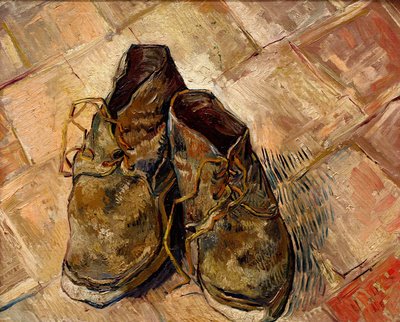
The painting here is called "A Pair of Shoes" by Vincent Van Gogh. I feel like those shoes sometimes. In a very real way those shoes and I are soul brothers (no pun intended). Old, worn out, scarred, scuffed and weary, they have put many a hard mile behind them and are enjoying a deserved rest. These shoes look strangely comfortable to me, as though the shoes and the wearer had become as one, and they appear to be waiting patiently for the journey to begin once again.
Vincent Van Gogh has long been one of my favourite artists. His work was much more than mere represntation, reproducing the world around him in colour and light. His work reached into the soul of the painter himself and exposed us to an inner landscape. Our own meloncholies and dreams, our fears and hopes, our simple ups and downs are displayed in his wonderful pallet and frantic brush strokes.
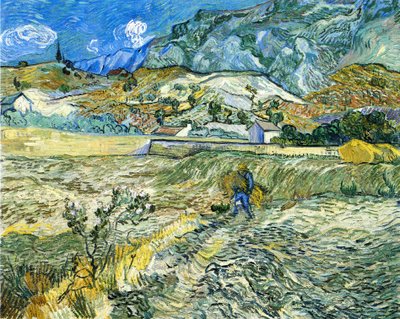
The painting here is called "Enclosed Field with Peasant". It is owned by the Indianapolis Museum of Art, if anyone in the neighborhood of Indiana is interested in seeing it. Van Gogh was a prolific artist. His sketches, watercolours, and paintings are many. I have seen them in Amsterdam and Paris, and I never visit London without making a beeline for the National Art Gallery and heading straight for the Van Gogh's.
Vincent Van Gogh opened the door for, and greatly influenced, that school of art called Expressionism . The deliberate distortion of reality and the use of colour and technique to portray the psychological and emotional landscape of the human condition. His use of bright and brilliant colour, coupled with his own unique vision and technique, led Vincent to produce some of the world's most treasured works of art...even though he only managed to sell one of his paintings in his lifetime.
His life as an artist is well documented in his letters to his brother Theo. The mental, emotional, and artistic travails of Van Gogh are played out in these letters. His lack of success as an artist and his failures at love and relationships, coupled with the emotional burden of deep meloncholy lows and manic highs, led to eventual breakdown and suicide. All of this is captured for all time in his work. But, more than all of this, there is pure and honest beauty.